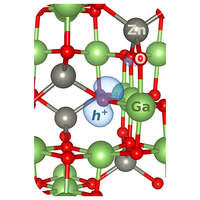Intrinsic origins of broad luminescence in melt-grown ZnGa2O4 single crystals
IF 3.4
3区 材料科学
Q2 MATERIALS SCIENCE, MULTIDISCIPLINARY
引用次数: 0
Abstract
This work explores the luminescence properties of melt-grown single crystals using photoluminescence spectroscopy and first-principles calculations. The photoluminescence spectra consist of numerous overlapping broad bands in the spectral range between 1.4 and 3.9 eV, which can be divided into low- (1.4–2.7 eV) and high-energy (2.7–3.9 eV) parts. When using below-gap excitation, the photoluminescence spectrum shows distinct orange and ultraviolet luminescence bands peaking at 1.99 and 3.36 eV, respectively. The results are interpreted by using configuration coordinate diagrams derived from hybrid functional calculations for self-trapped holes, as well as for the most stable native defects and their complexes. The calculations show that self-trapped holes, Zn antisites, and Zn-Ga antisite pairs give rise to strongly overlapping luminescence lines that are compatible with the high-energy side of the broad emission. For the low-energy side, we suggest Zn vacancies and their complexes with Ga antisites as potential intrinsic origins. The calculated Zn vacancy lineshape fits well with the orange luminescence band. Ga vacancies are unlikely to be the origin of the observed visible and ultraviolet emission, as the calculated luminescence lines occur in the infrared region. Moreover, complexes between the Ga vacancy and one or two Ga antisites, which would show luminescence at higher energies, are only metastable. It is more favorable for a Ga antisite to jump into the Ga vacancy, replacing the Ga antisite and vacancy with a Zn vacancy.

熔融生长的 ZnGa2O4 单晶宽发光的内在原因
这项研究利用光致发光光谱和第一原理计算探讨了熔融生长的 ZnGa2O4 单晶的发光特性。光致发光光谱由 1.4 至 3.9 eV 光谱范围内的许多重叠宽带组成,可分为低能(1.4-2.7 eV)和高能(2.7-3.9 eV)两部分。当使用低于隙激发时,光致发光光谱显示出明显的橙色和紫外发光带,峰值分别为 1.99 和 3.36 eV。利用混合函数计算得出的配置坐标图解释了自俘获空穴以及最稳定的原生缺陷及其复合物的结果。计算结果表明,自俘获空穴、Zn 反异质体和 Zn-Ga 反异质体对会产生强烈重叠的发光线,这些发光线与宽发射的高能侧相符。对于低能侧,我们建议将锌空位及其与镓反相石的复合物作为潜在的内在来源。计算得出的 Zn 空位线形与橙色发光带非常吻合。镓空位不太可能是观测到的可见光和紫外线发射的来源,因为计算出的发光线出现在红外区域。此外,镓空位与一个或两个镓对位体之间的络合物会在更高能量下发光,但这种络合物只能是稳定的。一个 Ga 反杂质跃迁到 Ga 空位中,用一个 Zn 空位取代 Ga 反杂质和空位,这对 Ga 空位更有利。
本文章由计算机程序翻译,如有差异,请以英文原文为准。
求助全文
约1分钟内获得全文
求助全文
来源期刊

Physical Review Materials
Physics and Astronomy-Physics and Astronomy (miscellaneous)
CiteScore
5.80
自引率
5.90%
发文量
611
期刊介绍:
Physical Review Materials is a new broad-scope international journal for the multidisciplinary community engaged in research on materials. It is intended to fill a gap in the family of existing Physical Review journals that publish materials research. This field has grown rapidly in recent years and is increasingly being carried out in a way that transcends conventional subject boundaries. The journal was created to provide a common publication and reference source to the expanding community of physicists, materials scientists, chemists, engineers, and researchers in related disciplines that carry out high-quality original research in materials. It will share the same commitment to the high quality expected of all APS publications.
 求助内容:
求助内容: 应助结果提醒方式:
应助结果提醒方式:


